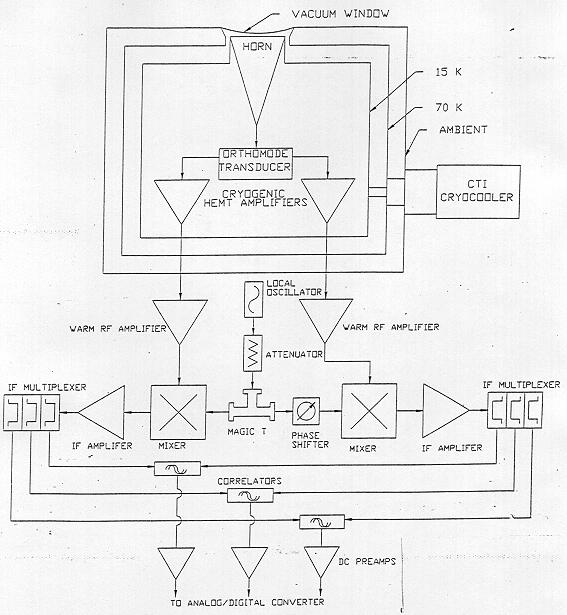
For our experiment, we need a special radio telescope that is tuned just right to be sensitive to microwaves and also sensitive to their polarization. The setup that we use is similar to that used in every common radio. We need an antenna to sense the radiation, we need some "plumbing" to pass this signal to our receiver, and in the receiver, we need a lot of amplification to boost the strength of the signal to a level that we can manipulate.
Below is a diagram of our receiver.

Above you can see that we are using a horn as our antenna. This is so we only receive photons from a small area of the sky at any time. Our horn is made so that the it can collect photons from an area of 7 degrees on the sky, roughly 14 moon diameters would fit in this area. From the horn, the collected radiation encounters the Orthomode Transducer, which separtes it into two linearly polarizaed components and sends the two components down different lines. Each signal is then amplified by a factor of 1000 by the HEMT (High Electron Mobilitry Transistors) amplifiers. HEMTs are nice because they have very low noise when used at low temperatures, and this is important to us because we need to keep noise as low as possible to detect such tiny signals. In fact, this experiment is made possible by the invention of these amplifiers. It is part of the reason that the field of Observational Cosmology has boomed in the last decade.
 Our two HEMT amplifiers.
Our two HEMT amplifiers.
We must keep the horn and these amplifiers cold for them to work optimally, and we do this by keeping them in a cryostat dewar. In here, we keep a vacuum and we continually cool with a commercial cryo-cooler. It is the same idea as your everyday thermos. Outside the dewar, the signals encounter further amplification and they are mixed with an oscillator signal to shift them to lower frequency. The signals are then correlated and sent to our data aquisition systems.

What the POLAR Dewar would look like if you cut it open.
If we hope to be able to achieve the necessary sensitivity to see polarization in the CMB, then we will have to know any instrumental sources of error to a high accuracy. With this in mind, we have been performing many tests to quantify the performance of various parts of POLAR. When we are satisfied that things are working as well as they can, we will take the POLAR telescope outside and make further fine tuning by looking at sources in the sky that have a known temperature. In this way, we can calibrate the instrument to a high degree of accuracy.
When all of the testing and the calibration has made POLAR sensitive enough, we will put it on the roof of the tallest building in Madison, and start taking data.
 Advanced Experimental Description |